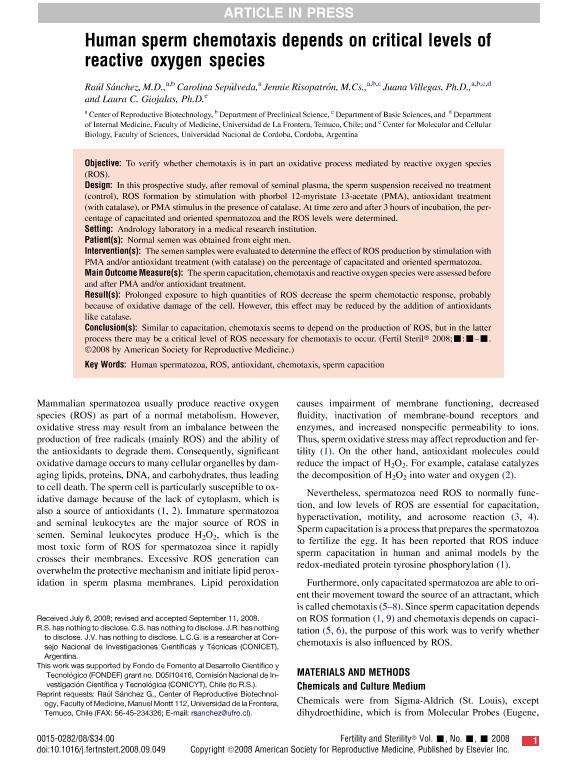Mostrar el registro sencillo del ítem
dc.contributor.author
Sánchez, Raúl Oscar

dc.contributor.author
Sepúlveda, Carolina
dc.contributor.author
Risopatrón, Jennie
dc.contributor.author
Villegas, Juana
dc.contributor.author
Giojalas, Laura Cecilia

dc.date.available
2018-08-30T18:22:00Z
dc.date.issued
2010-01-01
dc.identifier.citation
Sánchez, Raúl Oscar; Sepúlveda, Carolina; Risopatrón, Jennie; Villegas, Juana; Giojalas, Laura Cecilia; Human sperm chemotaxis depends on critical levels of reactive oxygen species; Elsevier Science Inc; Fertility and Sterility; 93; 1; 1-1-2010; 150-153
dc.identifier.issn
0015-0282
dc.identifier.uri
http://hdl.handle.net/11336/57744
dc.description.abstract
Objective: To verify whether chemotaxis is in part an oxidative process mediated by reactive oxygen species (ROS). Design: In this prospective study, after removal of seminal plasma, the sperm suspension received no treatment (control), ROS formation by stimulation with phorbol 12-myristate 13-acetate (PMA), antioxidant treatment (with catalase), or PMA stimulus in the presence of catalase. At time zero and after 3 hours of incubation, the percentage of capacitated and oriented spermatozoa and the ROS levels were determined. Setting: Andrology laboratory in a medical research institution. Patient(s): Normal semen was obtained from eight men. Intervention(s): The semen samples were evaluated to determine the effect of ROS production by stimulation with PMA and/or antioxidant treatment (with catalase) on the percentage of capacitated and oriented spermatozoa. Main Outcome Measure(s): The sperm capacitation, chemotaxis and reactive oxygen species were assessed before and after PMA and/or antioxidant treatment. Result(s): Prolonged exposure to high quantities of ROS decrease the sperm chemotactic response, probably because of oxidative damage of the cell. However, this effect may be reduced by the addition of antioxidants like catalase. Conclusion(s): Similar to capacitation, chemotaxis seems to depend on the production of ROS, but in the latter process there may be a critical level of ROS necessary for chemotaxis to occur.
dc.format
application/pdf
dc.language.iso
eng
dc.publisher
Elsevier Science Inc

dc.rights
info:eu-repo/semantics/openAccess
dc.rights.uri
https://creativecommons.org/licenses/by-nc-sa/2.5/ar/
dc.subject
Antioxidant
dc.subject
Chemotaxis
dc.subject
Human Spermatozoa
dc.subject
Ros
dc.subject
Sperm Capacition
dc.subject.classification
Otras Ciencias Biológicas

dc.subject.classification
Ciencias Biológicas

dc.subject.classification
CIENCIAS NATURALES Y EXACTAS

dc.title
Human sperm chemotaxis depends on critical levels of reactive oxygen species
dc.type
info:eu-repo/semantics/article
dc.type
info:ar-repo/semantics/artículo
dc.type
info:eu-repo/semantics/publishedVersion
dc.date.updated
2018-08-13T17:06:26Z
dc.journal.volume
93
dc.journal.number
1
dc.journal.pagination
150-153
dc.journal.pais
Estados Unidos

dc.journal.ciudad
Nueva York
dc.description.fil
Fil: Sánchez, Raúl Oscar. Universidad de La Frontera; Chile
dc.description.fil
Fil: Sepúlveda, Carolina. Universidad de La Frontera; Chile
dc.description.fil
Fil: Risopatrón, Jennie. Universidad de La Frontera; Chile
dc.description.fil
Fil: Villegas, Juana. Universidad de La Frontera; Chile
dc.description.fil
Fil: Giojalas, Laura Cecilia. Consejo Nacional de Investigaciones Científicas y Técnicas. Centro Científico Tecnológico Conicet - Córdoba. Instituto de Investigaciones Biológicas y Tecnológicas. Universidad Nacional de Córdoba. Facultad de Ciencias Exactas, Físicas y Naturales. Instituto de Investigaciones Biológicas y Tecnológicas; Argentina. Universidad Nacional de Córdoba. Facultad de Ciencias Exactas, Físicas y Naturales. Centro de Biología Celular y Molecular; Argentina
dc.journal.title
Fertility and Sterility

dc.relation.alternativeid
info:eu-repo/semantics/altIdentifier/url/https://www.sciencedirect.com/science/article/pii/S0015028208039472
dc.relation.alternativeid
info:eu-repo/semantics/altIdentifier/doi/http://dx.doi.org/10.1016/j.fertnstert.2008.09.049
Archivos asociados
